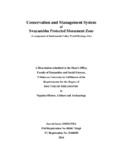Please use this identifier to cite or link to this item:
http://archive.nnl.gov.np:8080/handle/123456789/124| Title: | Conservation and management system of Swayambhu Protected Monument Zone (a component of Kathmandu Valley World Heritage Site) |
| Authors: | Shrestha, Suresh Suras |
| Keywords: | Swayambhu Protected Monument Zone Nepal |
| Issue Date: | 25-Dec-2018 |
| Abstract: | Cultural heritages have been preserving continuously by the communities since the time memorable, which is especially created for the socio-cultural activities. History of Nepalese cultural heritage conservation and management system however, goes back up to 3rd century BC, but we have only the dated and written history since 5th century CE. Since that time, cultural heritage conservation and management system is continuously coming down through the traditional mechanism by one to another generation. History of conservation and management system in Swayambhu Protected Monument Zone also goes back to 5th century CE; when Swayambhu was most popular either for Nepalese or for other neighboring countries, it is a tranquility between Hinduism and Buddhism. In the beginning, mostly royals and royal families, high class people as well as the commoners established a system for taking care of monuments what they created, we have several inscriptions on it, when they had introduced some principles and given responsibilities of these to the communities and individuals as well. This kind of system has been continuing in Malla period and Shah period and also defined some new principles according to the time and context. The Lichchhavi period in the history of Nepal, the most advanced conservation and management system was developed. At that time guthi as gosthi was developed for conservation and management system on entire monuments constructed; that is proved by most of the inscriptions from Lichchhvi period. These gosthi were generally established by kings or royal family members as well as by commoners. The people not only built monuments, but also left behind a long tradition of maintaining them through the system of guthi (local trusts). Malla period or medieval period also continued this system, but some significant principles were developed in this period and governmental institution, Chhenbhadel Adda was established in Shah period for this purpose, however others continued in this period as well. Later, in the modern period, formal government agencies as well as other institutions were developed for preservation, conservation and management of heritage. When all the responsibilities were handled by the state or the government, gradually the traditional system has been disappeared. Government legislations were promulgated and governed to the heritage conservation and management system and also adopted several international legislations; World Heritage Convention is among them; Nepal signed it. Then, Kathmandu Valley was listed in the World Heritage List in 1979, where Swayambhu Protected Monument Zone is one of the components of it. Therefore, there are several national as well as the international legislations are existed for conservation and management of the sites. The multiple legislations provisioned multiple stakeholders and their responsibilities however, it is a big issue, problem and challenges as well. In present system at Swayambhu PMZ, the major legislation for conservation and management of entire heritage area is Ancient Monument Preservation Act, 2013 and its regulation as well as the IMF of KVWHP and building bylaw for Swayambhu; however, the World Heritage Convention, 1972 and Operational Guidelines for Implementation of World Heritage are also implemented much importantly for managing and conserving the site; however the multiple legislations and stakeholders are crucial to manage site and within this complexity traditional system has also been existing continuously beyond these all formal system as a hidden mechanism in the society. |
| Description: | A dissertation submitted to the Dean's office, Faculty of Humanities and Social Sciences, Tribhuvan University in fulfillment of the requirements for the degree of Doctor of Philosophy in Nepalese History, Culture and Archaeology, Nepal, 2016. |
| URI: | http://103.69.125.248:8080/xmlui/handle/123456789/124 |
| Appears in Collections: | 300 Social sciences |
Files in This Item:
| File | Description | Size | Format | |
|---|---|---|---|---|
| SURESH_PhD_DISSERATATION_HERMGMT_2074.4.9.pdf | 6.28 MB | Adobe PDF |  View/Open |
Items in DSpace are protected by copyright, with all rights reserved, unless otherwise indicated.